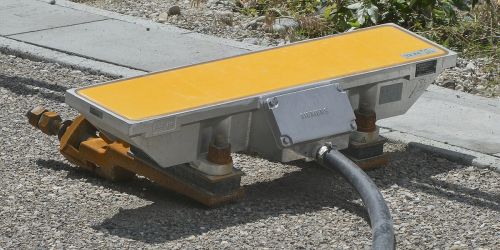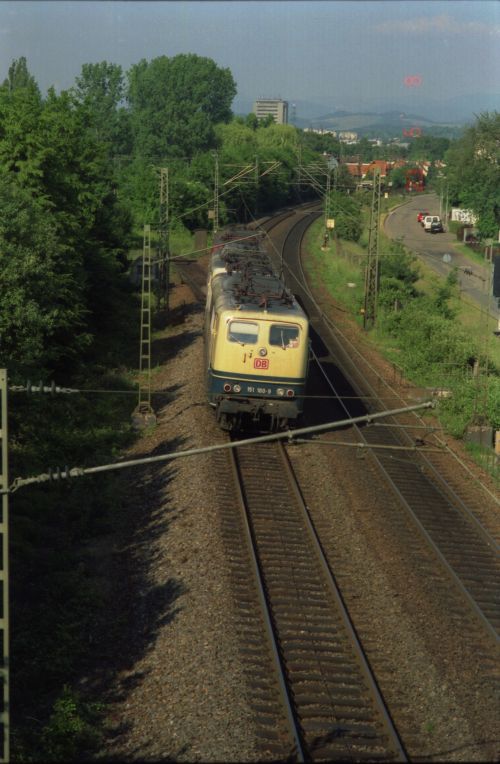Introduction
Documentation
Syntax
|
|
| Documentation
|
Allows specifying technical installations to ensure safe operation in the event of human error.
|
| Subschema
|
infrastructure
|
| Parents*
|
trainProtectionElements
|
| Children
|
areaLocation (0..*), designator (0..*), elementState (0..*), gmlLocation (0..*), isValid (0..*), linearLocation (0..*), name (0..*), networkLocation (0..*), spotLocation (0..*), typeDesignator (0..*)
|
Attributes:
- basedOnTemplate: reference to a template train protection element/system (optional;
xs:IDREF),
- medium: the medium for transferring the control command from the interlocking unit to the train protection field element, e.g. "inductive" for magnets (optional;
xs:string)
- Possible values:
- cable: With the line control continuous monitoring of the speed is possible. The vehicle data is transmitted from the vehicle device to the Linienzugbeeinflussung headquarters, where the target speed is determined, which in turn is then transmitted to the on-board unit via the line cable installed in the track. The vehicle is addressed via its position. The on-board device determines the driving data (e.g. actual, target, target speed, target distance), which is displayed in the driver's cab [Matthias Grimm et.al. Anforderungen an eine sicherheitsrelevante Ortung im Schienenverkehr]
- inductive: A type of train protection system that utilizes permanent magnets installed in the track. One example is the German Indusi (germ. Induktive Signalsicherung) that works on the same way by using tuned circuits trackside and on board. That close coupling between both circuits takes place only at discrete points, so the information is spot transmitted. They provide for an attentiveness check at the signals which can show „Caution“, trainstop functions and more or less complex supervision functions, but without calculating a dynamic speed profile [Tomislav Josip Mlinaric et.al. The impact of Indusi technology on disruption of interoperability in European rail traffic]
- mechanical: As a means to reduce the consequence of a Signal Passed At Danger and to ensure that a train sufficiently comes to rest within an overlap, trainstops are implemented as mechanical devices colocated next to an end of authority that will activate a trip cock arm on a train causing an emergency brake intervention [ RISSB AS 7711 Signalling Principles – Public Comment Draft]
- radio: uses GSM digital radio with continuous connectivity [Oleh Shchuryk. Finished Vehicle Logistics by Rail in Europe. the Association of European Vehicle Logistics]. In radio operation, the route and trains are secured and the elements of the route are controlled by radio. The special feature is that the route elements are controlled from the vehicle instead of from the operations center [Matthias Grimm et.al. Anforderungen an eine sicherheitsrelevante Ortung im Schienenverkehr].
- rail: It is Continuous Automatic Train Signalling (???? - ?????????????? ???????????? ???????????? ???????????? ????????) used widely on the main lines of the ex-Soviet states. It uses modulated pulses inducted into rails similar to the Italian RS4 Codici and American Pulse Code Cab Signaling. On high-speed lines the variant ALS-EN (???-??) is used which takes advantage of a double phase difference modulation carrier frequency. Use of several distinct pulse train patterns of alternating current flowing through a track circuit to convey an aspect of the next signal. The circuit comprises the feedpoint at the next signal, one running rail, first locomotive axle, another running rail and back to the signal feedpoint. The resulting electromagnetic field is picked up by receiver coils located just front of the first axle of the locomotive. The signal is then amplified, filtered and evaluated [ Oleh Shchuryk. Finished Vehicle Logistics by Rail in Europe. the Association of European Vehicle Logistics],
- monitoring: the way how the train protection field element is communicating with the monitoring central interlocking unit (optional;
xs:string)
- Possible values:
- continuous: transmit control data continuously from track to train. This enables the ATP system not only to protect but also to guide the train [Jörn Pachl Railway Signalling Principles]
- intermittent: the data is transmitted to the train at discrete points along the track. Data transmission points are provided at signals and sometimes at selected intermediate locations between signals [Jörn Pachl Railway Signalling Principles]
- none: It is used if there is no train protection.,
- trainProtectionSystem: definition of the national train protection system, which is installed at the track;
use value from the separate codelist file 'TrainProtectionSystems.xml'/trainProtectionSystemsAtTrack (optional; xs:string),
- id: the identifier of the object; this can be either of type xs:ID or UUID (obligatory;
xs:ID); compare: Dev:Identities
|
*Notice:
Elements may have different parent elements. As a consequence they may be used in different contexts.
Please, consider this as well as a user of this wiki as when developing this documentation further.
Aspects that are only relevant with respect to one of several parents should be explained exclusively in the documentation of the respective parent element.
|
|
|
| Documentation
|
Allows specifying technical installations to ensure safe operation in the event of human error.
|
| Subschema
|
infrastructure
|
| Parents*
|
trainProtectionElements
|
| Children
|
areaLocation (0..*), designator (0..*), external (0..*), gmlLocations (0..*), isValid (0..*), linearLocation (0..*), name (0..*), networkLocation (0..*), spotLocation (0..*), typeDesignator (0..*)
|
Attributes:
- basedOnTemplate: reference to a template train protection element/system (optional;
xs:string; patterns: (urn:uuid:)?[0-9a-fA-F]{8}-[0-9a-fA-F]{4}-[0-9a-fA-F]{4}-[0-9a-fA-F]{4}-[0-9a-fA-F]{12}|{[0-9a-fA-F]{8}-[0-9a-fA-F]{4}-[0-9a-fA-F]{4}-[0-9a-fA-F]{4}-[0-9a-fA-F]{12}}),
- medium: the medium for transferring the control command from the interlocking unit to the train protection field element, e.g. "inductive" for magnets (optional;
xs:string)
- Possible values:
- cable: With the line control continuous monitoring of the speed is possible. The vehicle data is transmitted from the vehicle device to the Linienzugbeeinflussung headquarters, where the target speed is determined, which in turn is then transmitted to the on-board unit via the line cable installed in the track. The vehicle is addressed via its position. The on-board device determines the driving data (e.g. actual, target, target speed, target distance), which is displayed in the driver's cab [Matthias Grimm et.al. Anforderungen an eine sicherheitsrelevante Ortung im Schienenverkehr]
- inductive: A type of train protection system that utilizes permanent magnets installed in the track. One example is the German Indusi (germ. Induktive Signalsicherung) that works on the same way by using tuned circuits trackside and on board. That close coupling between both circuits takes place only at discrete points, so the information is spot transmitted. They provide for an attentiveness check at the signals which can show „Caution“, trainstop functions and more or less complex supervision functions, but without calculating a dynamic speed profile [Tomislav Josip Mlinaric et.al. The impact of Indusi technology on disruption of interoperability in European rail traffic]
- mechanical: As a means to reduce the consequence of a Signal Passed At Danger and to ensure that a train sufficiently comes to rest within an overlap, trainstops are implemented as mechanical devices colocated next to an end of authority that will activate a trip cock arm on a train causing an emergency brake intervention [ RISSB AS 7711 Signalling Principles – Public Comment Draft]
- radio: uses GSM digital radio with continuous connectivity [Oleh Shchuryk. Finished Vehicle Logistics by Rail in Europe. the Association of European Vehicle Logistics]. In radio operation, the route and trains are secured and the elements of the route are controlled by radio. The special feature is that the route elements are controlled from the vehicle instead of from the operations center [Matthias Grimm et.al. Anforderungen an eine sicherheitsrelevante Ortung im Schienenverkehr].
- rail: It is Continuous Automatic Train Signalling (???? - ?????????????? ???????????? ???????????? ???????????? ????????) used widely on the main lines of the ex-Soviet states. It uses modulated pulses inducted into rails similar to the Italian RS4 Codici and American Pulse Code Cab Signaling. On high-speed lines the variant ALS-EN (???-??) is used which takes advantage of a double phase difference modulation carrier frequency. Use of several distinct pulse train patterns of alternating current flowing through a track circuit to convey an aspect of the next signal. The circuit comprises the feedpoint at the next signal, one running rail, first locomotive axle, another running rail and back to the signal feedpoint. The resulting electromagnetic field is picked up by receiver coils located just front of the first axle of the locomotive. The signal is then amplified, filtered and evaluated [ Oleh Shchuryk. Finished Vehicle Logistics by Rail in Europe. the Association of European Vehicle Logistics],
- monitoring: the way how the train protection field element is communicating with the monitoring central interlocking unit (optional;
xs:string)
- Possible values:
- continuous: transmit control data continuously from track to train. This enables the ATP system not only to protect but also to guide the train [Jörn Pachl Railway Signalling Principles]
- intermittent: the data is transmitted to the train at discrete points along the track. Data transmission points are provided at signals and sometimes at selected intermediate locations between signals [Jörn Pachl Railway Signalling Principles]
- none: It is used if there is no train protection.,
- trainProtectionSystem: definition of the national train protection system, which is installed at the track;
use value from the separate codelist file 'TrainProtectionSystems.xml'/trainProtectionSystemsAtTrack (optional; xs:string),
- id: the identifier of the object; this can be either of type xs:ID or UUID (obligatory;
xs:string; patterns: (urn:uuid:)?[0-9a-fA-F]{8}-[0-9a-fA-F]{4}-[0-9a-fA-F]{4}-[0-9a-fA-F]{4}-[0-9a-fA-F]{12}|{[0-9a-fA-F]{8}-[0-9a-fA-F]{4}-[0-9a-fA-F]{4}-[0-9a-fA-F]{4}-[0-9a-fA-F]{12}}); compare: Dev:Identities
|
*Notice:
Elements may have different parent elements. As a consequence they may be used in different contexts.
Please, consider this as well as a user of this wiki as when developing this documentation further.
Aspects that are only relevant with respect to one of several parents should be explained exclusively in the documentation of the respective parent element.
|
|
|
| Documentation
|
This element is not documented in the schema!
|
| Subschema
|
infrastructure
|
| Parents*
|
trainProtectionElements
|
| Children
|
any (0..*), areaLocation (0..*), designator (0..*), external (0..*), gmlLocations (0..*), isValid (0..*), linearLocation (0..*), name (0..*), networkLocation (0..*), spotLocation (0..*)
|
Attributes:
- basedOnTemplate: reference to a template train protection element/system (optional;
xs:IDREF; patterns: (urn:uuid:)?[0-9a-fA-F]{8}-[0-9a-fA-F]{4}-[0-9a-fA-F]{4}-[0-9a-fA-F]{4}-[0-9a-fA-F]{12}|{[0-9a-fA-F]{8}-[0-9a-fA-F]{4}-[0-9a-fA-F]{4}-[0-9a-fA-F]{4}-[0-9a-fA-F]{12}}),
- trainProtectionSystem: definition of the national train protection system, which is installed at the track;
use value from the separate codelist file 'TrainProtectionSystems.xml'/trainProtectionSystemsAtTrack (obligatory; xs:string),
- medium: the medium for transferring the control command from the interlocking unit to the train protection field element, e.g. "inductive" for magnets (optional;
xs:string)
- Possible values:
- cable
- rail
- radio
- inductive
- mechanical,
- monitoring: the way how the train protection field element is communicating with the monitoring central interlocking unit (optional;
xs:string)
- Possible values:
- continuous
- intermittent
- none,
- id: the identifier of the object; this can be either of type xs:ID or UUID (obligatory;
xs:ID; patterns: (urn:uuid:)?[0-9a-fA-F]{8}-[0-9a-fA-F]{4}-[0-9a-fA-F]{4}-[0-9a-fA-F]{4}-[0-9a-fA-F]{12}|{[0-9a-fA-F]{8}-[0-9a-fA-F]{4}-[0-9a-fA-F]{4}-[0-9a-fA-F]{4}-[0-9a-fA-F]{12}}); compare: Dev:Identities
|
*Notice:
Elements may have different parent elements. As a consequence they may be used in different contexts.
Please, consider this as well as a user of this wiki as when developing this documentation further.
Aspects that are only relevant with respect to one of several parents should be explained exclusively in the documentation of the respective parent element.
|
Changes 3.1→3.2
There exists an overview of all changes between railML® 3.1 and railML® 3.2 on page Dev:Changes/3.2.
The element documentation has been changed.
The children have been changed.
The attributes have been changed.
Changes 3.2→3.3
There exists an overview of all changes between railML® 3.2 and railML® 3.3 on page Dev:Changes/3.3.
The children have been changed.
The attributes have been changed.
Semantics
Best Practice / Examples
Additional Information
Notes
Open Issues
Affected Tickets
#23

